
- Home
- India
- World
- Premium
- THE FEDERAL SPECIAL
- Analysis
- States
- Perspective
- Videos
- Sports
- Education
- Entertainment
- Elections
- Features
- Health
- Business
- Series
- In memoriam: Sheikh Mujibur Rahman
- Bishnoi's Men
- NEET TANGLE
- Economy Series
- Earth Day
- Kashmir’s Frozen Turbulence
- India@75
- The legend of Ramjanmabhoomi
- Liberalisation@30
- How to tame a dragon
- Celebrating biodiversity
- Farm Matters
- 50 days of solitude
- Bringing Migrants Home
- Budget 2020
- Jharkhand Votes
- The Federal Investigates
- The Federal Impact
- Vanishing Sand
- Gandhi @ 150
- Andhra Today
- Field report
- Operation Gulmarg
- Pandemic @1 Mn in India
- The Federal Year-End
- The Zero Year
- Science
- Brand studio
- Newsletter
- Elections 2024
- Events
Bitter story of a sweet delicacy: Why Bengal’s nolen gur faces an existential crisis

A tinge of nostalgia grips Shyamapada Biswas every winter morning as he gazes at a row of banana trees standing on a swathe of his land once graced by tall-cylindrical date-palm trees with their leafy crown. Winters had a special purpose in his life—that is until two years ago—when his banana grove was a date orchard.For over four decades, his daily winter-morning routine was to tighten...
A tinge of nostalgia grips Shyamapada Biswas every winter morning as he gazes at a row of banana trees standing on a swathe of his land once graced by tall-cylindrical date-palm trees with their leafy crown. Winters had a special purpose in his life—that is until two years ago—when his banana grove was a date orchard.
For over four decades, his daily winter-morning routine was to tighten the knot on his chequered lungi and climb to the top of date trees, before the sun rays could pierce the thick mist, to bring down earthen pitchers filled with sap of the tree.
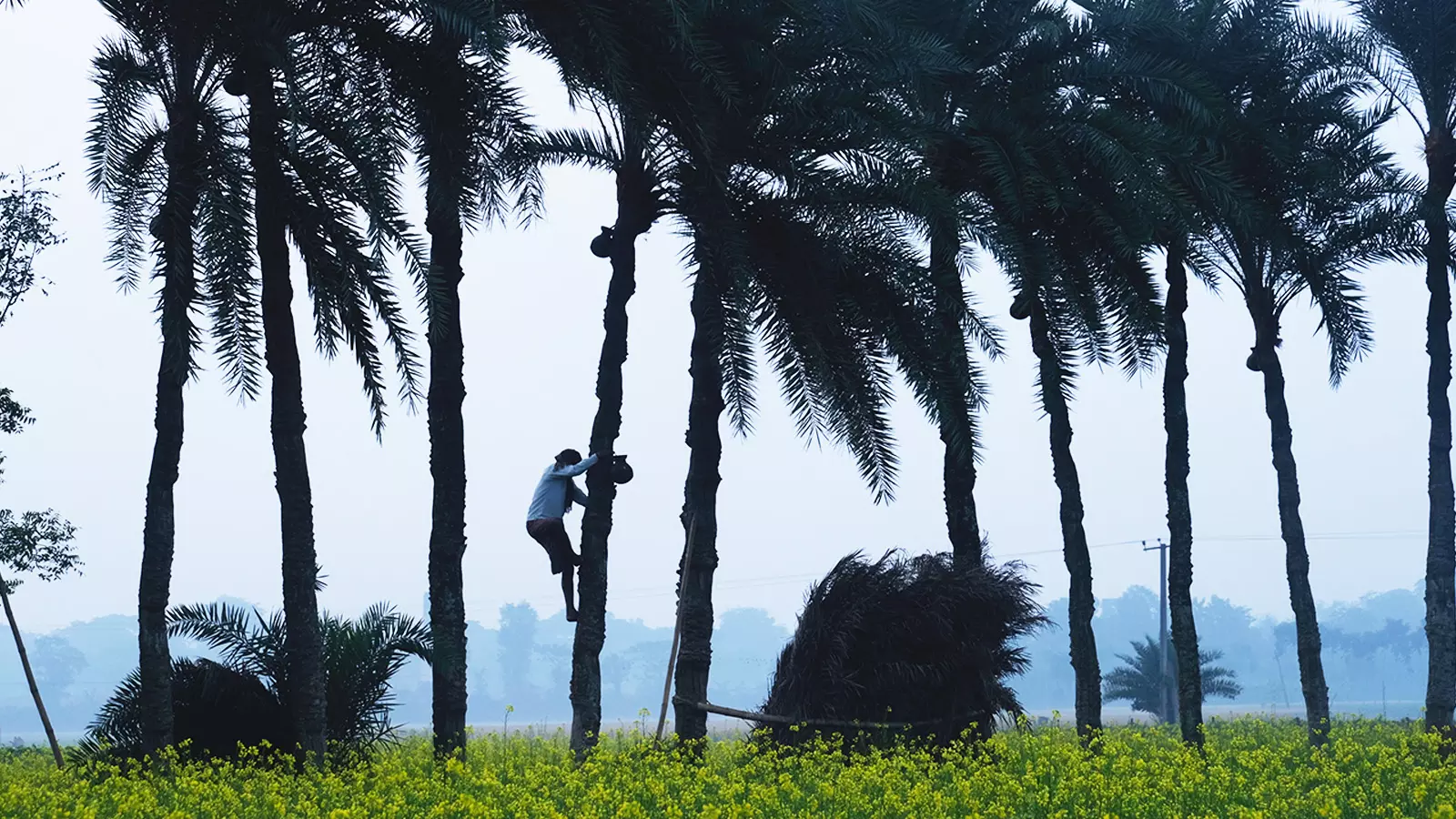
A shiuli climbs down a tree after collecting sap.
This is the chore many still follow in rural Bengal at the onset of the cold-sunny sea-son to bring to the platter of millions of sweet-toothed Bengalis their favourite winter-time delicacy—nolen gur (date-palm jaggery).
These sap collectors, called shiuli or gachia in Bengali, are seeing their profession on the verge of extinction due to climate change.
For the uninitiated, outside Bengal, the profession was immortalised by a character of Motalef, aka Moti, played by Amitabh Bachchan in a 1973-film Saudagar, an adaptation of Narendranath Mitra’s Bengali short story, Ras.
The sap is boiled over a wood-fired cauldron for more than an hour until it turns reddish black to become the priced nolen gur that forms an essential ingredient in winter delicacies like nolen gurer payesh (rice pudding), nolen gurer sandesh, nolen gurer pitha, nolen gurer rasogulla, etc. It can also be savoured standalone or as a dip with chapatis and breads. Not to mention that without nolen gur there will be no Joynagar Moa, a GI-tagged traditional laddu, synonymous with winter in Bengal.
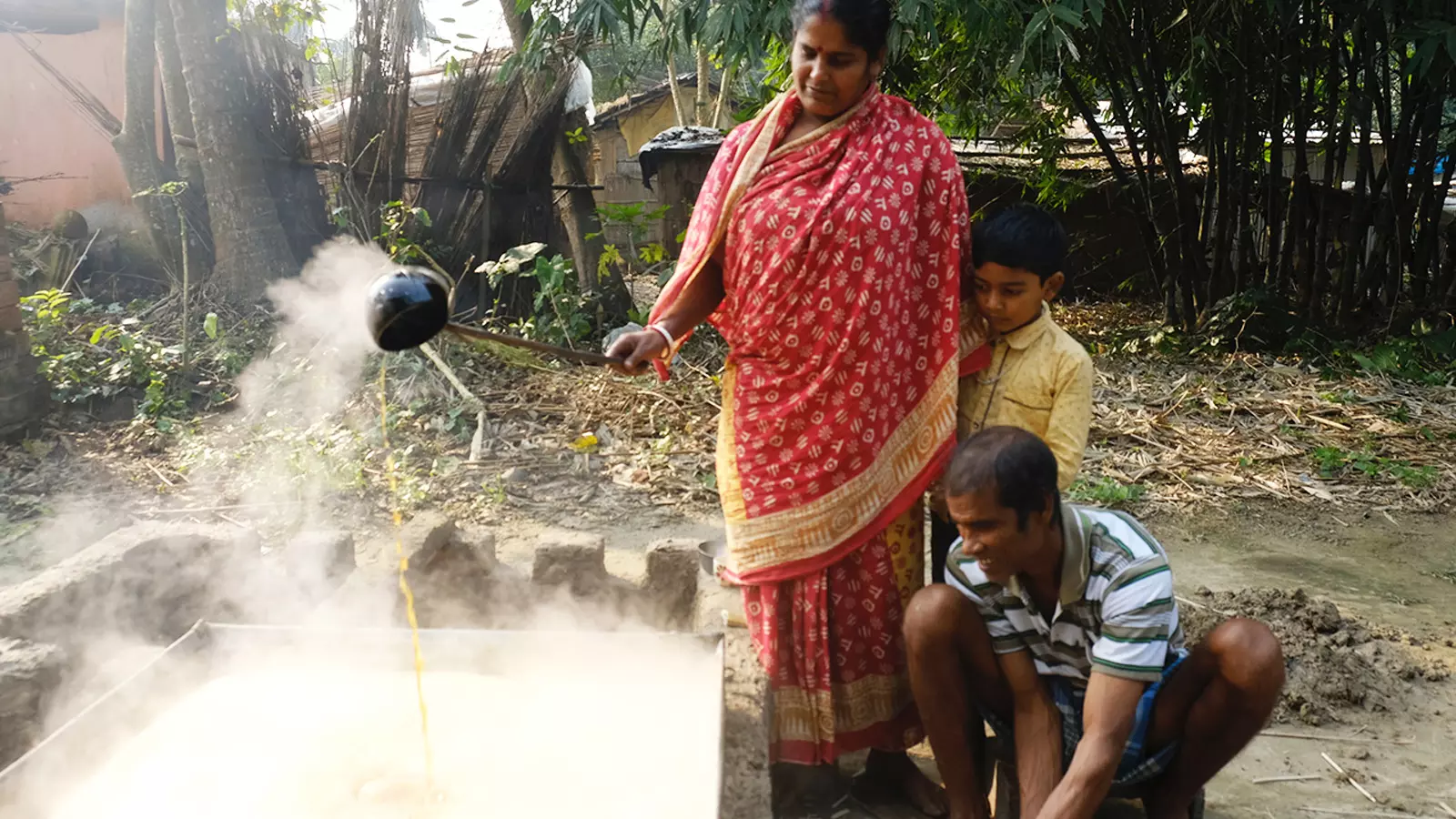
The sap is boiled over a wood-fired cauldron for more than an hour until it turns reddish black to become the priced nolen gur.
Apart from being delicious, it is also very nutritious being a source of good amounts of iron, magnesium, manganese, and potassium. Extraction of sap is a very specialised job. To collect it, the outer layer of the trunk near the tip of the tree is scraped with a sickle-like sharp iron matchet to expose the core.
“The incision has to be very precise. If the kernel is exposed more than usual, the quality of the sap will not be good. Moreover, a deep cut will damage the tree and it will die within a year,” Biswas said.
Once the core is exposed, an earthen pitcher is then linked to the exposed area with a thin bamboo stalk to collect the dripping sap drip by drip. The pitcher is slung on a tree the previous evening, after the sun starts setting, to accumulate the sap overnight.
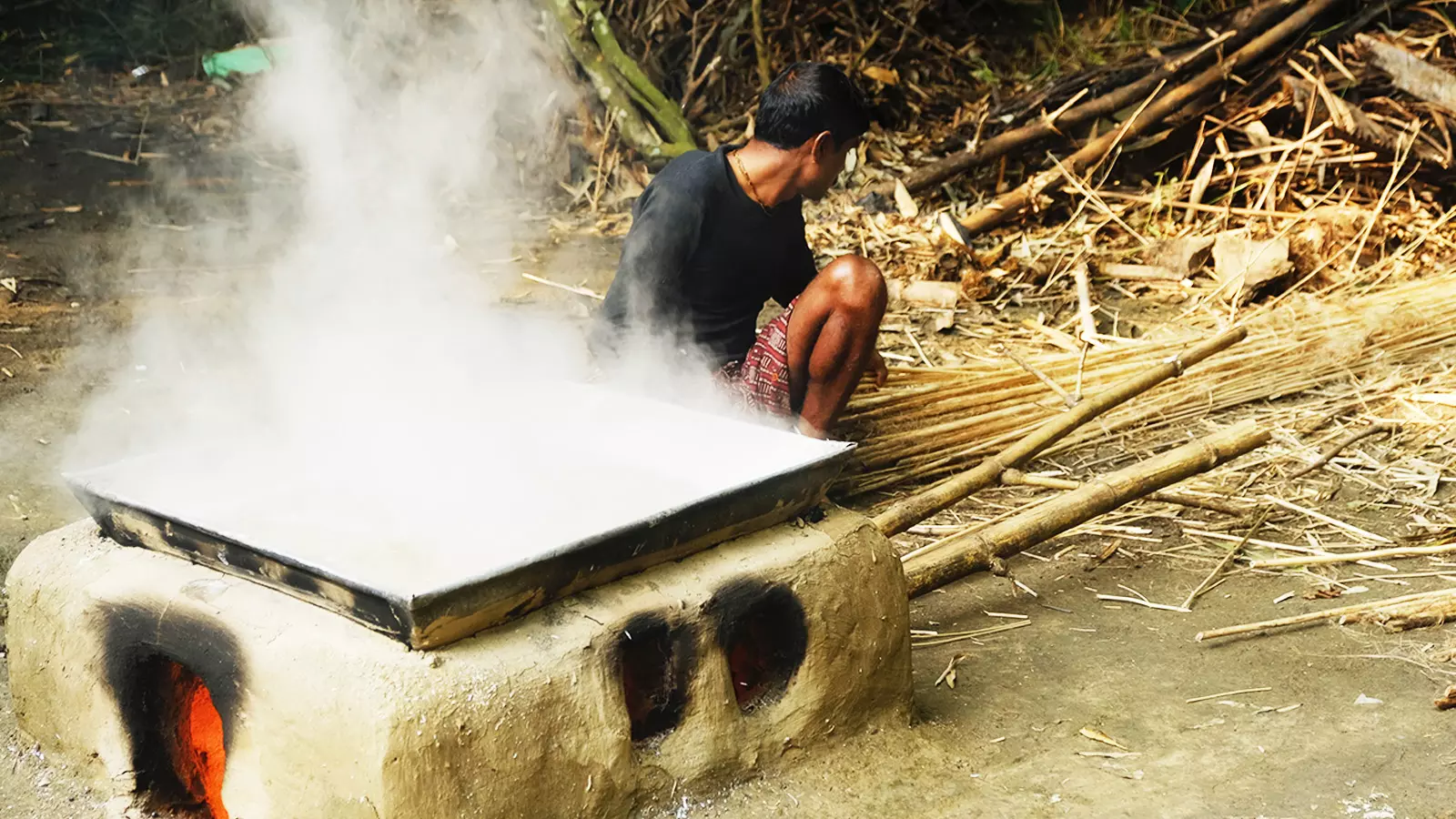
During a peak winter season, a healthy palm tree oozes out six to seven litres of sweet syrup overnight in a cycle of around three to five days.
The sap is very delicate and starts fermenting with the touch of sunlight. Hence, the collection process needed to be completed within dusk-to-dawn. That’s not the only immutable code. The sap has to be extracted only when temperatures go down to 14°Celsius, the condition required for the tree to produce enough sweet juice.
During a peak winter season, a healthy palm tree oozes out six to seven litres of sweet syrup overnight in a cycle of around three to five days. Therein lies the catch that made our protagonist, 63-year-old Biswas, and many of his ilk, to bid adieu to the profession.
During his young days, winter season in several parts of southern Bengal used to span over October to February, Biswas recalled. “Now the season is not only curtailed to just December to January, it is also very unpredictable, severely affecting the quality of the sap,” he pointed out.
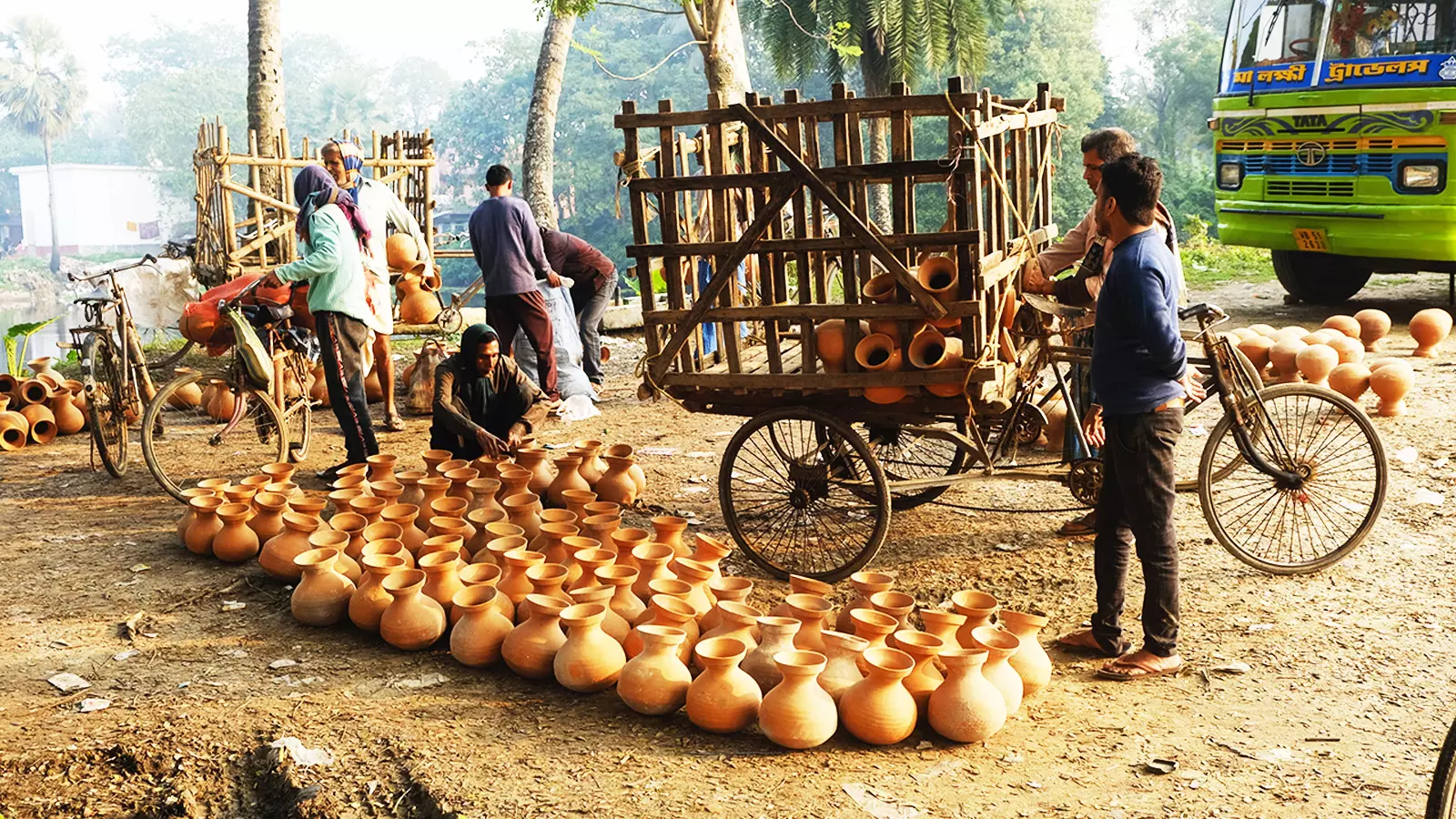
The pitchers in which the sap is collected.
Recurring floods and untimely rain further despoil the date trees of its valuable syrups. Flood is a double whammy. It increases the salinity of the soil, thus turning them unsuitable for date plantation. Moreover, it uproots trees causing habitat loss.
Unpredictability has forced many like Biswas to switch to more economically beneficial options like growing banana or betel-nut trees, cutting down date plants—a much sought-after source of fuel in brick kilns that dots Bengal’s palm-jaggery belt.
The best-quality palm jaggeries are sourced from Nadia, South 24 Parganas, Purulia and Bankura districts of West Bengal.
Majhdia, a village in Nadia district is regarded as the nolen-gur capital of Bengal. The village has a population of about 2,700, according to the 2011 census.
At least a member from one out of the two families in the village that has over 660 households worked as a shiuli even a decade ago, said Biswas, who hails from Majhdia’s Adityapur. Now, there are only 10-15 people in the village associated with the dying profession.
Stating that delayed winter and deforestation have turned out to be the main enemies of the nolen gur, Swapan Bhaumik, a social-activist from Majhdia, calls for an immediate intervention to preserve this important ingredient of Bengal’s food heritage.
Local sweet shop owners say that low sap collection and increasing demand has forced them to use sugar syrup to enhance the volume of jaggery.
Bhaumik suggested sustainable agriculture promotion through contract farming and prolonging the shelf life of the jaggery as some of the measures to encourage local farmers to stick to the date plantation.
“Demand for nolen gur is huge. In fact, there is a huge supply demand mismatch. This has led to proliferation of cheap adulterated nolen gur in the market,” he added.
Some popular sweet outlets of the state have already started giving annual procurement contracts to some farmers, he said.
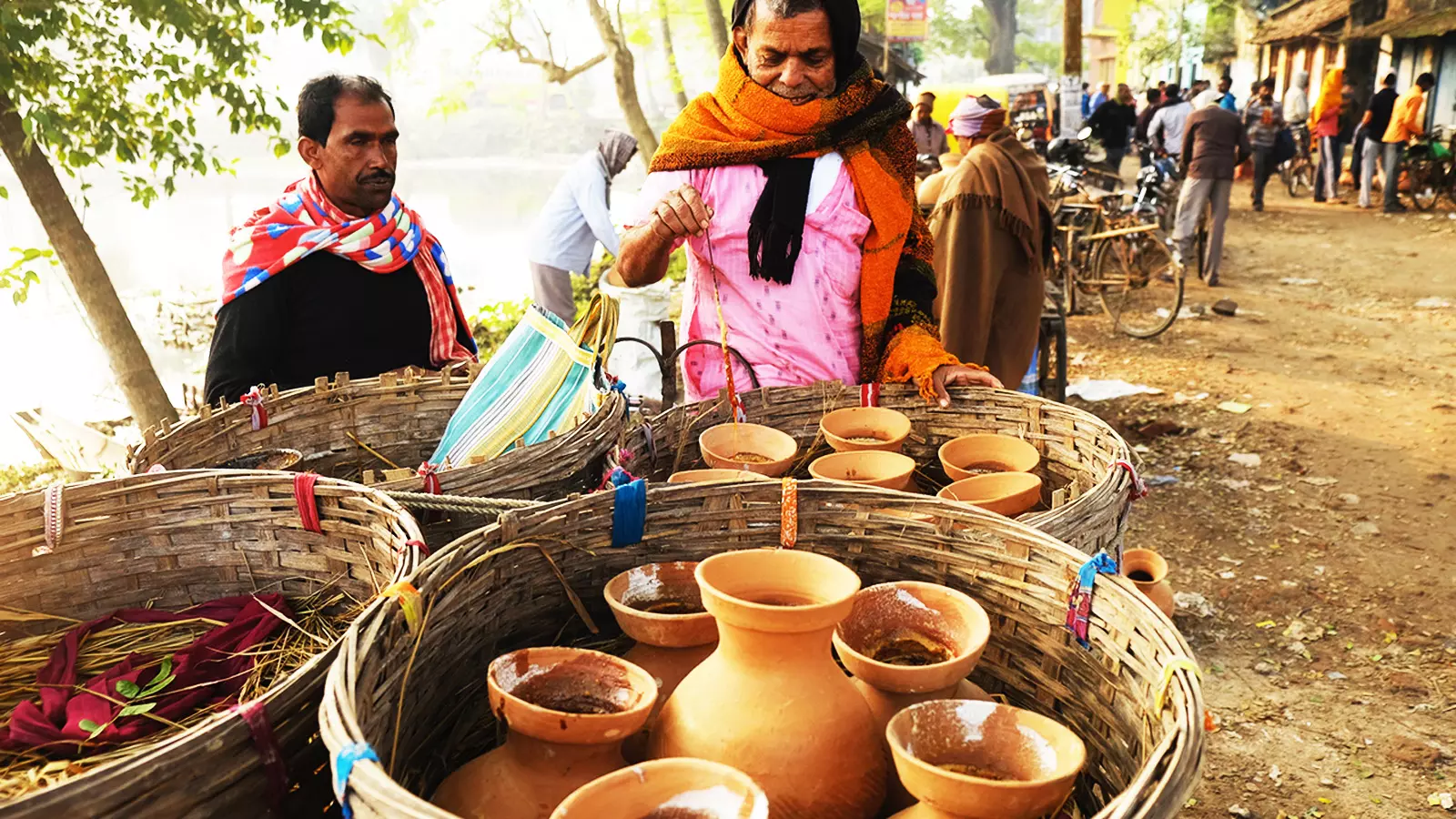
The sap pitcher on sale
West Bengal Khadi and Village Industries Board too has started a soft-intervention project at the grassroots by undertaking cluster development on packaging of nolen gur in Nadia district. The objective of the project is to create marketing avenues and packaging innovations to extend shelf life.
The board is already marketing the jaggery in laminated collapsible plastic tubes after collecting the product from its pilot project in Majhdia. The initial project costs Rs 384.36 lakh with an aim to provide employment to 200 people, an official said.
It includes setting up of a common facilitating centre with modern machinery and a laboratory for quality control.
Without nolen gur winter season will not be the same again in this part of the world. Biswas’s melancholic reminiscence of the days when date palm sap was integral to his winter days is suggestive of the foretaste.
